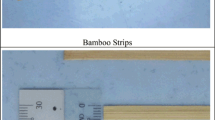Abstract
Bamboo reinforced epoxy possesses reasonably good properties to waarrant its use as a structural material, and is fabricated by utilizing bamboo, an abundant material resource, in the technology of fibre composites. Literature on bamboo-plastics composites is rare.
This work is an experimental study of unidirectional bamboo-epoxy laminates of varying laminae number, in which tensile, compressive, flexural and interlaminar shear properties are evaluated. Further, the disposition of bamboo fibre, the parenchymatous tissue, and the resin matrix under different loading conditions are examined. Our results show that the specific strength and specific modulus of bamboo-epoxy laminates are adequate, the former being 3 to 4 times that of mild steel. Its mechanical properties are generally comparable to those of ordinary glass-fibre composites. The fracture behaviour of bamboo-epoxy under different loading conditions were observed using both acoustic emission techniques and scanning electron microscopy. The fracture mode varied with load, the fracture mechanism being similar to glass and carbon reinforced composites. Microstructural analyses revealed that natural bamboo is eligibly a fibre composite in itself; its inclusion in a plastic matrix will help solve the problems of cracking due to desiccation and bioerosion caused by insect pests. Furthermore, the thickness and shape of the composite can be tailored during fabrication to meet specific requirements, thereby enabling a wide spectrum of applications.
Similar content being viewed by others
References
R. M. JONES, “Mechanics of composite materials” (Kingsport Press, McGraw-Hill, 1975).
S. W. TSAI and H. T. HAHN, “Introduction to composites”, (Technonic Publishing, Pennsylvania, 1980).
B. HARRIS, “High Modulus Polymers and Composites”, edited by C. L. Choy (Chinese University Press, Hong Kong, 1985) p. 253.
J. A. MOCK,Mater. Engng 3 (1979) 60.
M. A. MANSUR and M. A. AZIZ,Int. J. Cem. Comp. 2 (1982) 75.
S. C. LAKKAD and J. M. PATEL,Fibre Sci. Technol. 14 (1981) 319.
U. C. JINDAL,Indian For. 4 (1984) 381.
B. PAKOTIPRAPHA, R. P. PAMA and S. I. LEE,Int. J. Hous. Sci. Appl. 3 (1979) 167.
K. M. GINSBURG and F. G. SHIN, “High Modulus Polymers and Composites” edited by C. L. Choy (Chinese University Press, Hong Kong, 1985) 433.
S. H. KWAN, F. G. SHIN and M. W. YIPP,Acta Materiae Compositae Sinica 4 (1987) 79.
Author information
Authors and Affiliations
Rights and permissions
About this article
Cite this article
Shin, F.G., Xian, X.J., Zheng, W.P. et al. Analyses of the mechanical properties and microstructure of bamboo-epoxy composites. J Mater Sci 24, 3483–3490 (1989). https://doi.org/10.1007/BF02385729
Received:
Accepted:
Issue Date:
DOI: https://doi.org/10.1007/BF02385729




